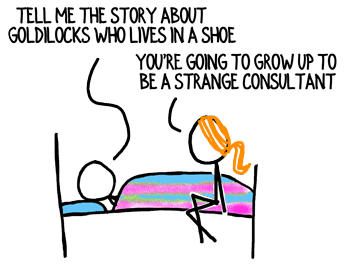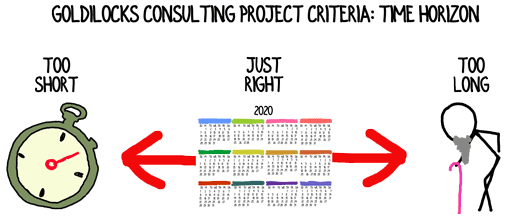Let’s finish up with Goldilocks, that unrepentant trespasser, porridge thief and handy metaphor for everything “just right.”
When last we left our fair-haired bear bait, she was pointing to Significance as one of the key indicators of the perfect project for your consulting firm. (See this article.) Goldi’s Five-by-Five zone consists of your prospect’s top five priorities and his boss’s top five priorities.
Consulting opportunities in the Five-by-Five zone are within the reach of your contact’s pay grade, and generally important enough to warrant seeking help.

However, Goldilocks wistfully notes another factor you should consider, because: 1) she should have left the bear’s house before the cops showed up, and 2) Significance alone can lead you astray.
Plenty of “top priorities” never cross the finish line and plenty of consulting proposals on high-priority challenges never convert into signed projects.
The real winners—the projects that hold the most promise for your consulting firm—emerge when you (and Goldi) also keep an eye on the…
Time Horizon
The Time Horizon looks at your prospect’s Five-by-Five zone and probes, “Yeah, I get those are your priorities… but can you give me the time scale?”
You may think that the smaller the scale the better (“It’s my top priority this minute!”), since that implies high urgency.
Time Horizon is different from urgency, though.
Urgency helps you close projects; Time Horizon helps you identify the right projects to close.
To be clear, more urgency is virtually always better. For instance, extreme urgency allowed a consulting firm I talked to early this week to sign a project within hours of their first contact with a prospect. (Yes, the prospect reached out in the morning and agreed to the scope and fees in the afternoon!)
However, a Time Horizon that’s too short can indicate a priority that’s fleeting, low value, or already handled.
For instance, consider your consulting prospect’s priority for the moment (“I’m starving. Lunch, anyone?”), for the day (“I must complete this audit by [5:00]”) and even for the month (“I’m meeting with the Big Cheese in three weeks”). All reside in the Five-by-Five zone, but none indicate enticing consulting opportunities.
On the flip side, you don’t want your consulting firm to chase huge, long-term priorities that occupy the corporate equivalent of a bucket list. (“My number one priority is to leave a legacy when I retire… in 30 years.”)

The perfect Time Horizon for a consulting project generally falls in a narrow band:
From quarterly goals to three-year plans.
You’re looking for Five-by-Five priorities associated with the next three to 36 months.
Multiple, linked milestones inside the ideal Time Horizon are even better. For instance, consulting heaven is when your prospect says, “I need help identifying an acquisition target that I can present to my Board this quarter. That’s the only way I’ll be able to make an acquisition this year, and that’s the linchpin in my three-year plan.”
Use Significance and Time Horizon together to triangulate on your perfect, consulting project opportunities.
Now that you know what those Goldilocks projects look like, you’ll find them easier to spot.
You can also proactively uncover excellent consulting opportunities with a question like, “What are your top priorities and your boss’s top priorities over the next quarter, year and couple of years?”
What have you found to be the ideal Time Horizon for your consulting practice’s projects?
Text and images are © 2024 David A. Fields, all rights reserved.

 David A. Fields Consulting Group
David A. Fields Consulting Group 

Within this framework, things seem to go better if there is action needed soon on that 3 year priority. And a shorter-term milestone and benefit to be achieved. Your ‘consulting heaven’ example is a good illustration.
You’re right, Julie-ann. Some short-term urgency is still needed in order to close the project. (Every one of the Six Pillars of Consulting Success must be in place.)
Three years seems to be the outside edge of priorities that clients act on now. Quarterly seems to be the inside edge on priorities that have enough heft to warrant high fees and margins. Again, separate the Time Horizon for the goal from the urgency around getting the project done. This framework is meant to help you identify great projects to pursue.
Thanks for highlighting the role of a near-in milestone, Julie-ann. That’s an important point to keep in mind.
Can you clarify… are you looking for the top 5 priorities overall and then applying the time frame? Or are you looking for the top 5 priorities for the quarter, then the top 5 for the year, and then the top 5 for the 3 yr horizon? There may be some overlap with the latter, however you could wind up with different answers. When asking for the top 5 priorities, over what timeframe is it most helpful to ask for?
Great question, Debbie. Sometimes consultants will ask a prospect, “What are your top priorities?” But that question leaves out the Time Horizon, and can lead to discussions of priorities outside the Goldilocks zone of ideal opportunities.
Or, you could ask, “What are your top priorities for the year?” That’s better; however, it’s only one point in the ideal Time Horizon.
Therefore, I like to ask for the top priorities across the quarter-to-three-year range and just see what pops out. The prospect may tell me about the big, 3 year goals that they’re working on right now, or the challenge that’s threatening the current half may be most on his mind.
The idea is to set the broad parameters you want (Five-by-Five Significance, 1/2 to 3-year Time Horizon) and let the prospect direct you to the big opportunities within those parameters.
I’m glad you asked for clarification!
The ‘burning platform’ was a concept I was introduced to 30 years ago….does the potential client have an issue that really must be addressed or is an important task within a current strategic or business plan (so there is a budget)….and hopefully you can present a strong case for being the person/firm to most effectively help address that issue (at an acceptable cost). Also, does the contact have contracting authority so you know you are dealing with the decision-maker and not an intermediary. The strategic plan task might in fact being something that will require examination and more than a quick turnaround (a 3-year horizon) while there might be an operational improvement opportunity that can have ‘immediate’ impact… a shorter time horizon. Recently did work around restructuring the go to market strategy for a business that would require implementation of some real changes in CRM and sales force training and management as well as some missing technical competencies. We can define the need and build the case but then the execution is critical to delivering results. So I agree that not all leads are created equally and it is wise to better understand what is ‘right’
The burning platform metaphor is often an apt one, and hearkens back to my early days in consulting too. In 1988 the Piper Alpha oil platform exploded and a survivor talked of his decision to leap 15 stories to the icy waters below as one of pitting likely death against certain death.
Not every ideal project is fueled by a burning platform, but when prospects are faced with undeniable threats to their very existence, their projects are unquestionably in the Goldilocks areas of Signficance and Time Horizon.